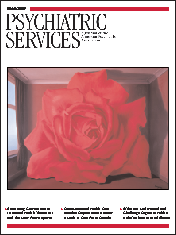Inequity in Mental Health Care Under Canadian Universal Health Coverage
Abstract
OBJECTIVE: Previous research has produced conflicting evidence about socioeconomic disparities in mental health care under universal health coverage in Canada. This study sought to determine equity in the delivery of ambulatory services from psychiatrists and family physicians for mental health problems in this setting. METHODS: Outpatient billing claims and neighborhood socioeconomic status were examined with cross-sectional analysis. The study area consisted of the central southern portion of the city of Toronto, Ontario, including the city's downtown core. This urban setting is an economically and culturally diverse area. A total of 1,221 homogeneous enumeration areas (local neighborhoods) were surveyed, and data were examined for the 746,141 residents of these areas who had had a health visit in 2000. Rates of mental health visits to family physicians and psychiatrists were compared across socioeconomic quintiles. Socioeconomic status was determined according to educational attainment in the enumeration area. RESULTS: Claimants from neighborhoods with the highest socioeconomic status were 1.6 times as likely as those from neighborhoods with the lowest socioeconomic status to use psychiatric care. Among persons who received care from a psychiatrist, claimants from neighborhoods with the highest socioeconomic status had significantly more psychiatric claims than those from neighborhoods with the lowest socioeconomic status. No significant gradients were found for either sex for any use of mental health care provided by family physicians. Among females, service users from the highest socioeconomic areas had more mental health visits to family physicians than those from the lowest socioeconomic areas. CONCLUSIONS: Marked socioeconomic disparities were found in the use of care from a psychiatrist. Unlimited coverage of physician-provided mental health care is insufficient to fairly distribute services to those most in need.



